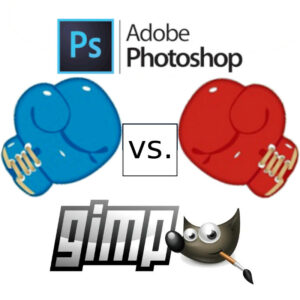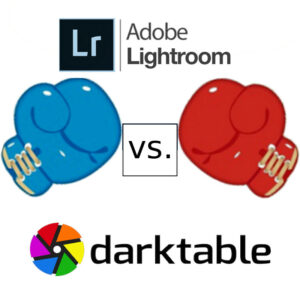Adobe Photoshop vs. The GIMP
 The GIMP is a powerful and free open source alternative to Adobe Photoshop. Adobe Photoshop reigns supreme in image editing software, renowned for its extensive capabilities and professional-grade tools. However, for those seeking a powerful yet cost-effective solution, The GIMP emerges as a compelling alternative.
The GIMP is a powerful and free open source alternative to Adobe Photoshop. Adobe Photoshop reigns supreme in image editing software, renowned for its extensive capabilities and professional-grade tools. However, for those seeking a powerful yet cost-effective solution, The GIMP emerges as a compelling alternative.
In 2012, Adobe’s decision to transition Photoshop from a perpetual licensing model to a subscription-based one caused a significant stir among its customer base. While the company touted the benefits of the subscription model, such as access to continuous updates and cloud storage, many customers expressed dissatisfaction with the shift.
The primary concern raised by customers was the recurring cost associated with the subscription model. Unlike the perpetual license model, where users paid a one-time fee for lifetime access to the software, the subscription model required users to pay a monthly or annual fee to continue using Photoshop. This ongoing cost structure was particularly unsettling for professional users who relied heavily on Photoshop for their livelihoods. Adobe’s annual revenue has more than doubled since the company transitioned to the subscription model. In 2011, the year before the transition, Adobe’s revenue was $4.2 billion. In 2022, Adobe’s revenue was $20.9 billion.
The GIMP stands apart from Adobe Photoshop in its fundamental approach: it’s entirely free and open-source. This not only eliminates the financial barrier to entry but also fosters a vibrant community of developers and users constantly refining and expanding the software’s capabilities.
Adobe offers additional programs like Illustrator and Lightroom. There are open source alternatives for those programs as well. Read our comparisons on Adobe Illustrator vs. Inkscape, and Adobe Lightroom vs. Darkroom.
Adobe Photoshop offers a vast array of features and capabilities, but numerous studies suggest the vast majority of Photoshop users are not using the full potential of the software:
-
According to a study by Adobe, the average Photoshop user only uses 20% of the software’s features.
-
Another study by Nielsen Norman Group found that 80% of Photoshop users only use a subset of the most basic features, such as cropping, resizing, and adjusting brightness and contrast.
-
A survey by Creative Bloq found that only 2% of Photoshop users use all of the software’s features.
One of the biggest differences between Photoshop and GIMP is their handling of non-destructive editing. Photoshop offers a more robust non-destructive editing workflow, which allows users to make changes to their images without affecting the original data. This means that users can always revert back to the original image if they make a mistake. GIMP also offers some non-destructive editing capabilities, but they are not as comprehensive as Photoshop’s.
Adobe Photoshop is a large, resource hungry program that has substantial hardware requirements to run. The GIMP has much lower hardware requirements making it ideal for users with older computers. The GIMP runs on Windows and MacOS, and also runs on Linux. Adobe Photoshop does not run on Linux.
For many users The GIMP may offer all the capabilities they need. If you’re seeking a powerful, free, and open-source image editing tool that empowers your creative vision, The GIMP is the answer.
Adobe Photoshop vs. The GIMP Feature Comparison
| Feature | Adobe Photoshop | GIMP |
|---|---|---|
| 1st Year Released | 1987 | 1995 |
| Cost | Subscription-based (Creative Cloud) | Free and open-source |
| Platform | Windows, macOS | Windows, macOS, Linux |
| Hardware Requirements | Adobe recommends having at least 4GB of free RAM and 100GB of available hard disk space. | The GIMP recommends having at least 2GB of free RAM and 10GB of available hard disk space. |
| User Interface | Intuitive, user-friendly | Functional but less polished |
| Layer Support | Advanced layer management | Layer support, but less sophisticated |
| Image Editing Tools | Extensive and powerful | Comprehensive but may lack some advanced features |
| Selection Tools | Advanced selection tools | Good selection tools, but may lack some advanced features |
| Color Correction | Advanced color correction tools | Powerful color correction tools |
| Filters and Effects | Extensive library of filters and effects | Solid collection, but fewer in number |
| Text Editing | Advanced text editing and styling | Text editing capabilities |
| Brushes and Drawing Tools | Extensive brush library and drawing tools | Good selection of brushes and tools |
| RAW Editing | Excellent RAW file support | Basic RAW editing capabilities |
| Automation and Batch Processing | Robust automation and scripting capabilities | Basic automation and scripting support |
| 3D Editing | Advanced 3D editing features | Limited or no 3D editing capabilities |
| Smart Objects | Supports smart objects for non-destructive editing | Limited or no support for smart objects |
| Plugins and Extensions | Large community of third-party plugins and extensions | Smaller but active community |
| Community and Support | Extensive official support and tutorials | Active community, but may have fewer official resources |
Adobe Photoshop offers several features for image editing, manipulation, and composition that The GIMP currently does not offer. Here are some of the primary features that Adobe Photoshop offers that The GIMP currently does not have:
-
Content-Aware Fill: Photoshop’s Content-Aware Fill utilizes AI and machine learning to seamlessly remove unwanted objects or fill in empty areas by analyzing the surrounding context and generating realistic patterns or textures. The GIMP lacks this advanced feature, relying on manual techniques like cloning or using the Healing Brush tool.
-
Refine Edge: Photoshop’s Refine Edge tool provides precise control over selecting and refining edges, particularly for complex subjects like hair or fur. The GIMP’s edge selection tools are less sophisticated, making it more challenging to isolate intricate subjects accurately.
-
Lens Correction: Photoshop’s Lens Correction filters automatically correct common lens distortions such as chromatic aberration, vignetting, and lens curvature. The GIMP offers limited lens correction capabilities compared to Photoshop, requiring manual adjustments or third-party plugins.
-
3D Tools: Photoshop includes a comprehensive set of 3D tools for creating, editing, and rendering 3D objects and integrating them into 2D compositions. The GIMP lacks native 3D capabilities and relies on external plugins or workarounds.
-
Advanced Painting Tools: Photoshop offers a range of advanced painting tools, including Blend Modes, Brush Presets, and the Mixer Brush, which provide flexibility and control for digital painting. The GIMP’s painting tools are less extensive, limiting the expressiveness of digital art creation.
-
Plugin Ecosystem: Photoshop has a vast ecosystem of third-party plugins that add specialized features and enhance its functionalities. While The GIMP also has a plugin community, the range and availability of plugins are not as extensive.
-
Cloud Integration: Photoshop integrates with Adobe Creative Cloud, providing access to cloud storage, collaboration tools, and shared libraries. The GIMP offers limited cloud integration, primarily relying on third-party services.
-
Performance Optimization: Adobe continuously optimizes Photoshop’s performance, particularly for large file handling and complex operations. The GIMP’s performance can sometimes be slower, especially when working with demanding tasks.
-
User Interface Customization: Photoshop’s user interface is highly customizable, allowing users to tailor the workspace to their preferences and workflow. The GIMP’s user interface is less customizable, limiting the flexibility of workspace arrangements.
AI Integration Into Adobe Photoshop
Adobe Firefly is a cloud-native generative AI platform that is integrated into Adobe Photoshop. Adobe Firefly is designed to help creative professionals create and edit content more efficiently and effectively using artificial intelligence. It provides a range of features, including:
-
Automatic image generation: Firefly can generate new images based on a text prompt or an existing image. This can be used to create new concepts, explore different design options, or quickly generate variations of an existing image.
-
Image editing: Firefly can be used to edit images in a variety of ways, including removing objects, changing backgrounds, and adjusting colors.
-
Content optimization: Firefly can optimize content for different platforms and audiences. For example, it can generate different versions of a product description for different social media platforms.
Adobe Firefly is rapidly evolving and has the potential to revolutionize the way creative professionals work. It has the potential to make content creation faster, easier, and more creative. At the time of this writing The GIMP does not have AI Integration, although there are several plugins that use AI.

 Inkscape is a free and open-source vector graphics editor. It is used for creating or editing vector graphics, which are images created using mathematical equations to define shapes. Inkscape is particularly well-suited for tasks such as logo design, illustration, web design, and other graphic design projects.
Inkscape is a free and open-source vector graphics editor. It is used for creating or editing vector graphics, which are images created using mathematical equations to define shapes. Inkscape is particularly well-suited for tasks such as logo design, illustration, web design, and other graphic design projects. Darktable is a free and open-source photography workflow application and raw developer. It is often considered a powerful alternative to commercial photo editing software. Darktable is designed for managing digital negatives and processing raw images from digital cameras.
Darktable is a free and open-source photography workflow application and raw developer. It is often considered a powerful alternative to commercial photo editing software. Darktable is designed for managing digital negatives and processing raw images from digital cameras.
Recent Comments